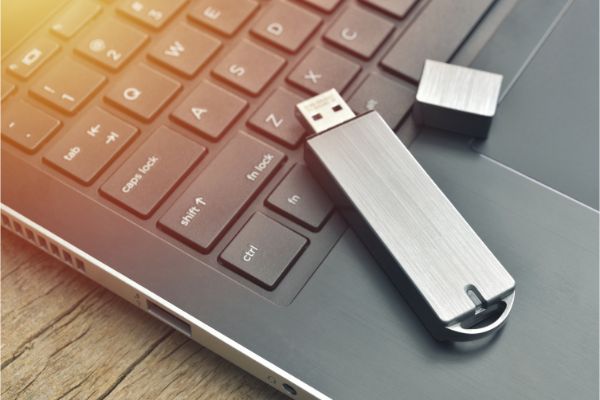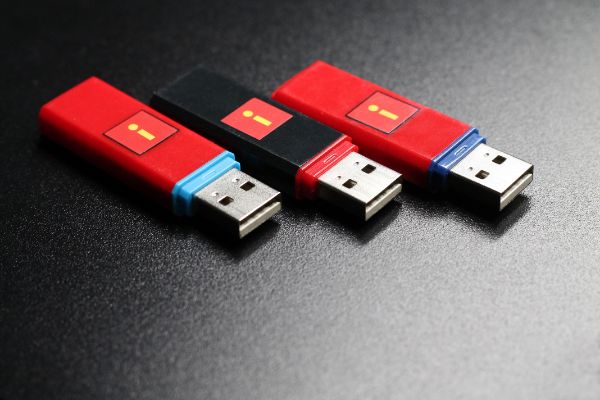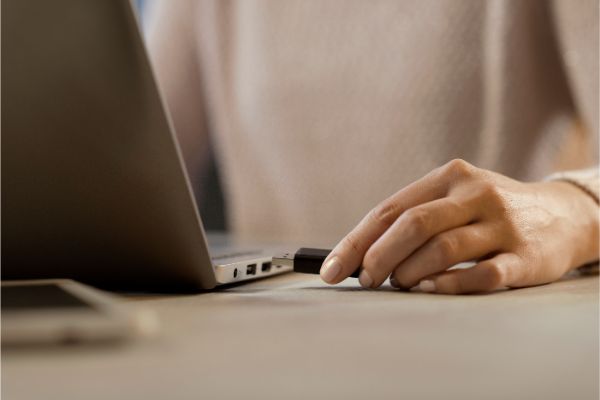Disclaimer: This post may contain affiliate links, meaning we get a small commission if you make a purchase through our links, at no cost to you. For more information, please visit our Disclaimer Page.
Flash drives are susceptible to corruption just like any other piece of tech you own. From physical damage to software glitches, many things can cause a flash drive to fail. But with a little bit of knowledge and preventive care, you can avoid losing your data for good.
Table of Contents
11 Potential Reasons Your Flash Drive is Corrupting
1. PC Suddenly Shuts Down
One of the most common reasons your USB flash drive might get corrupted is if there is a sudden loss of power. This could happen if your computer shuts down or the power goes out. If this happens, it can cause the data on your USB flash drive to become corrupt.
Another reason your USB flash drive might get corrupted is if your operating system crashes. This could happen if you are using an older version of Windows that is not compatible with your computer’s hardware or if there’s a sudden fatal error that causes BSOD.
2. Unplugging USB Without Ejecting
You’re risking data corruption when you unplug a USB storage device without first ejecting it. That’s because the process of unplugging the device doesn’t give the operating system enough time to properly close all the files that are open on the device. This can lead to lost data or, in some cases, partially overwritten or otherwise corrupted files.
Most people don’t know this, but it is necessary to eject a USB before unplugging it. If you don’t, you risk damaging the drive and losing any data on it. When you plug a USB into a computer, the two devices establish a connection.
This connection allows data to flow between the two devices. If you simply unplug the USB without first ejecting it, the connection is broken abruptly and can cause damage to the drive.
Ejecting the USB essentially tells the computer to break the connection safely so that no harm is done. Once the USB is removed, you can unplug it without damaging it.
3. File Catalog Corruption
File catalog corruption happens when the catalog, which is basically an index of all the files on the drive, becomes corrupt. When this happens, the drive can no longer keep track of where all the files are located, resulting in data getting lost or corrupted.
There are a few things that can cause this to happen:
- Physical damage to the drive. This can happen if the drive is dropped or otherwise physically damaged.
- Improper ejection of the drive. Ejecting the drive without using the safely removed hardware feature in Windows can cause corruption.
- Using the drive on multiple computers.
4. Copying Too Many Files at Once
Your flash drive keeps corrupting because you’re copying too many files simultaneously. When you copy multiple files simultaneously, it puts a strain on the flash drive and can cause errors. To avoid this, you should only copy one file at a time or use file management software that allows you to queue up files for copying.
While it’s tempting to just copy everything at once, it’s not worth the risk of losing your data. So, take a few extra seconds to copy your files one at a time, and you’ll avoid any headaches down the road.
5. Improper Directory Structure
When you copy files to your USB drive, they are typically stored in a root folder. However, some operating systems create additional folders, such as LOST.DIR or System Volume Information. These folders can cause problems when you try to access the files on your USB drive.
For example, if you want to save a text file called Untitled.txt in the root folder and there’s already a text file with that name in another folder (such as LOST.DIR), your computer will overwrite the original file with what’s in LOST.DIR without asking for permission first. It will also do this even if Untitled.txt was not saved yet.
6. Not Connecting USB Properly
If you connect your USB device to the wrong port or mishandle it while it’s plugged in, you can corrupt the data on the device. When you connect a USB, make sure it is plugged in all the way. You should also avoid using cheap or low-quality flash drives. If you use a low-quality USB, it could cause data transfer problems that lead to corruption.
Another cause of USB corruption is using the wrong port. Some computers have multiple USB ports, each designed for a different purpose. Make sure you’re using the correct port for your needs. For example, if you’re trying to charge your phone, use the charging port instead of the data port.
7. Broken STEMS
One of the most common problems with USB ports is broken STEMS. The STEM is the part of the USB port that the plug connects to. When the STEM is broken, it can cause the USB port to stop working correctly.
There are a few things that can cause STEM to break. The most common cause is physical damage. If the USB port is hit or bent, it can cause the STEM to break. Another common cause is prolonged use. Over time, the STEM can become worn down and eventually break.
If the STEM in your USB port is broken, there are a couple things you can do to try and fix it. The first thing you can try is to use a pencil to lightly press on the broken STEM. This can sometimes provide a temporary fix. Another option is to use a toothpick to slightly lift the broken STEM.
8. USB Hardware Components Are Damaged (NAND Memory Wear)
If your USB has cracks or chips in the casing, it’s likely that the data stored on it is no longer safe. Even if there doesn’t appear to be any physical damage, the delicate internals of a USB can easily become damaged if the device is dropped or jostled too much.
Over time, the NAND cells in your USB flash drive will begin to degrade. This is a normal part of their lifecycle, and as they degrade, they’ll become more susceptible to corruption. There are a few things that can speed up this process, like using your drive frequently or storing it in extreme temperatures.
If you’re noticing that your drive is corrupting more often than it used to, it’s likely due to NAND wear. If you suspect that your USB has suffered physical damage, the best course of action is to stop using it immediately and send it off to a professional data recovery service.
9. USB End of Life Reached
One potential reason your USB flash drive keeps getting corrupted is that it’s reached its end of life. This means the drive is no longer being supported by the manufacturer and may not be able to function correctly. There are a few ways to tell if this is the case:
- Your computer isn’t recognizing the drive.
- The drive isn’t showing up in File Explorer.
- You’re seeing error messages when you try to access the drive.
- The drive is slow or unresponsive.
If you think your USB flash drive might be at the end of its life, your best bet is to get a new one. But before you do, back up any critical data from the drive!
10. Driver Issues
Drivers are responsible for communicating data transfers between devices and the PC. If your computer doesn’t have the proper drivers installed, it won’t be able to properly communicate with the USB device.
This can lead to data being transferred incorrectly, which can corrupt the files on the drive. To fix this, you’ll need to ensure you have the latest drivers installed for your computer. You can do this by going to the manufacturer’s website and downloading the latest drivers.
11. Malware or Virus
It’s exceedingly rare for a USB flash drive to get infected with a virus, but it does happen. If you’ve ever wondered, “why is my flash drive getting corrupted?” then there’s a chance that it’s because of a malicious piece of software.
One way to tell if your flash drive is infected is if you start seeing strange files or programs popping up. If you see anything that you didn’t put there, it’s possible that your drive is infected. Another way to tell is if your computer starts acting strangely after you plug in the drive. If you notice any changes in your computer’s performance, there may be a virus on your flash drive.
9 Potential Fixes for Windows Users
1. Run Virus Scan
If you’re a Windows user, the first thing you should do is run a virus scan. Your USB drive may get corrupted because it’s infected with a virus. To run a virus scan, open your antivirus program and select the option to scan your flash drive. When the scan is complete, remove any viruses that are found.
2. Change USB Drive Letter
One potential fix for your corrupt USB drive is to change its drive letter. This can be done by
- Opening up the Disk Management tool.
- Right-click on your USB drive and select Change Drive Letter and Paths.
- If the change option is grayed out, your drive is not currently assigned a letter.
- Click Add and then assign it a letter of your choice.
With any luck, this will help fix the issue and allow you to access your files once again.
3. Update USB Drivers
Open the Device Manager and look for any devices with a yellow exclamation mark next to them. If you see any, right-click on the device and select Update Driver Software. If that doesn’t work, try uninstalling and then reinstalling the driver.
4. Run Check Disk from Command Prompt
If you have issues with your flash drive getting corrupted, you can run Check Disk from the Command Prompt. This tool will scan your drive for errors and repair them if possible.
To run Check Disk from the Command Prompt, you will need to open the Command Prompt as an administrator. To do this,
- Search for “Command Prompt” in the Start menu,
- right-click on the Command Prompt shortcut, and select “Run as administrator.”
Once the Command Prompt is open, type the following command and press Enter:
“`
chkdsk [drive letter]: /f
“`
Replace “[drive letter]” with the letter of the drive that you want to scan. For example, if your flash drive is assigned to the letter G, you would type “chkdsk G: /f.”
Please note that this process will take some time to complete. Do not close the Command Prompt or interrupt the process, as this can further damage your drive. Once complete, your flash drive should be working correctly again.
5. Use the ATTRIB Command
The ATTRIB command is a simple tool that can be used to protect your flash drive from corruption. This command tells the computer to store data in a certain way on the drive, which can help prevent corruption.
This command will fix the File Allocation Table (FAT) on your flash drive, which is usually the cause of the corruption. To use the ATTRIB command, simply open the Command Prompt and type in the following:
ATTRIB -h -r -s /S /D drive letter:\\*.*
Replace “drive letter” with the letter of your flash drive. Once you hit Enter, the command will start running and should fix the corruption on your flash drive.
6. Repair USB From Drive Properties Window
To fix a corrupted USB, you can try to repair it from the Drive Properties window. Right-click on the USB drive and select Properties. Go to the Tools tab in the Properties window and click on Check. The Check Disk Utility will scan your USB drive for errors and try to fix them.
7. Format the Drive
If you’ve tried all of the other options on this list and still have issues with your USB flash drive, you can try formatting the drive. This will erase all of the data on the drive, so make sure to back up any important files first.
To format a drive in Windows:
- Open My Computer,
- Right-click on the USB drive
- Select Format
- In the Format window, choose a file system (like NTFS),
- Choose the Quick Format option, and click Start.
8. Use File History To Recover Corrupted Files
File history is a feature in Windows 10 that automatically saves copies of files as you work on them. This can be a lifesaver if your files become corrupt or unsaved. You can simply revert back to an earlier version. If you have a flash drive with important files on it, you can use File History to help you recover those files if they become corrupted.
To use File History,
- Open the Control Panel and go to System and Security.
- Under the Backup and Restore section, click on the File History link. This will open the File History window, showing you a list of all the drives being backed up.
- Cl0ick on the drive that contains your flash drive.
- Click on the “Restore your files with File History” option.
- Once the scan is complete, you can choose which version of the file you want to restore.
9. Pay for Professional Recovery
If you have a flash drive that keeps getting corrupted, you may be wondering if it’s worth it to pay for professional services to fix the issue. After all, you can probably just buy a new flash drive for less than the cost of professional services.
However, if you have essential data on the flash drive that you can’t afford to lose, paying for professional services may be your best bet. A professional can help you retrieve the data from the corrupt drive and transfer it to a new one.
They can also diagnose the cause of the problem and help you avoid corruption in the future.
How To Prevent a USB From Getting Corrupt
There are some things you can do to prevent your USB drive from getting corrupt in the first place:
- First, properly eject your USB drive before unplugging it from your computer. This will help to prevent any data corruption that can occur when the drive is abruptly disconnected.
- Keep your USB drive away from strong magnets. Magnets can interfere with the data on your drive and cause it to become corrupt.
- Avoid using your USB drive in extreme temperatures, as this can cause the drive to malfunction.
- Do not remove your USB drive without first ejecting it, as this can lead to data corruption.
- Avoid using your USB drive on multiple computers, as this can cause corruption.
- Run a disk check on your USB drive regularly to check for bad sectors.
Following these simple tips can help keep your USB drive from becoming corrupt and losing your data.
How Often Do USB Flash Drives Get Corrupted?
It’s very common for USB flash drives to become corrupted. Many factors can contribute to data corruption, including physical damage, electrical problems, and software glitches. The good news is that there are ways to prevent data corruption.
Taking proper care of your USB drive and using data recovery software can help reduce the risk of data corruption and make it easier to recover your data if corruption does occur. If you’re using a USB flash, be sure to back it up regularly. And if you experience corruption, don’t panic; there are several ways to recover your data.
Conclusion
Your flash drive keeps corrupting because of various factors. The most significant cause is physical damage to the drive, which can occur from dropping or bumping the drive. Other causes include using the drive on multiple computers, malware infection, or an outdated or incompatible file system. You can fix these problems by following this guide.



